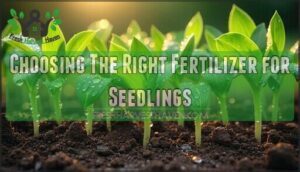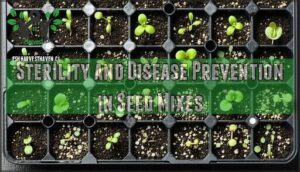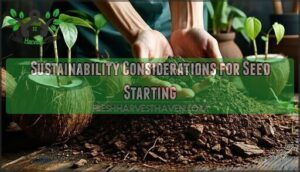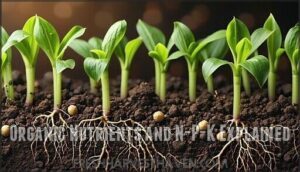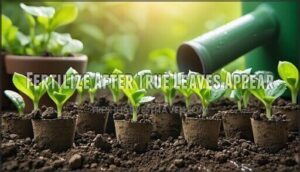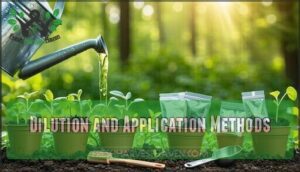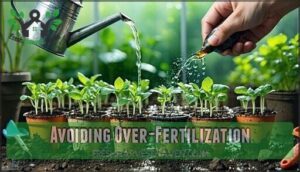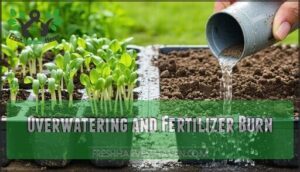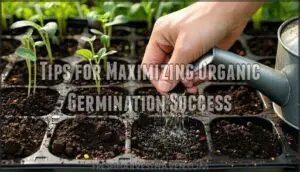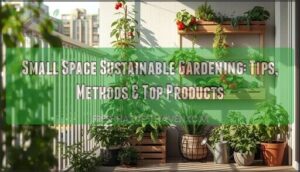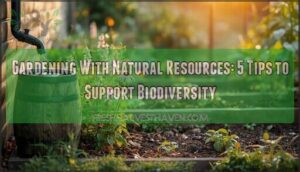This site is supported by our readers. We may earn a commission, at no cost to you, if you purchase through links.
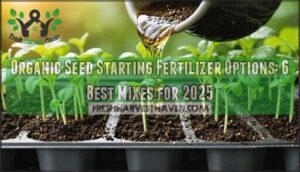
The best choices include balanced liquid fertilizers with equal N-P-K ratios or slightly higher nitrogen blends like 5-2-3, which you can dilute to quarter strength.
Organic kelp meal, fish emulsion, and compost-based starter mixes provide slow-release nutrients while maintaining proper pH levels.
These organic options create healthier soil biology compared to synthetic alternatives, reducing transplant shock and building stronger root development.
Smart timing matters too—you’ll want to wait until those first true leaves appear before introducing any fertilizer to avoid burning tender seedlings, which is crucial for stronger root development and preventing transplant shock.
Table Of Contents
- Key Takeaways
- 6 Best Organic Seed Starting Fertilizers
- Key Benefits of Organic Seed Starter Mixes
- Choosing The Right Fertilizer for Seedlings
- Sterility and Disease Prevention in Seed Mixes
- Sustainability Considerations for Seed Starting
- Organic Nutrients and N-P-K Explained
- When and How to Fertilize Seedlings
- Common Mistakes to Avoid With Seedlings
- Tips for Maximizing Organic Germination Success
- Frequently Asked Questions (FAQs)
- What is a good organic fertilizer for seedlings?
- How to make homemade seedling fertilizer?
- What fertilizer to use when seeding?
- Should you fertilize newly planted seeds?
- Can organic fertilizers burn or damage young seedlings?
- Whats the shelf life of liquid organic fertilizers?
- Can you make homemade organic seed starting mix?
- Do organic fertilizers attract pests or insects indoors?
- Conclusion
Key Takeaways
- Wait for true leaves before fertilizing – You shouldn’t add any fertilizer until your seedlings develop their first set of true leaves, typically 2-4 weeks after germination, to avoid burning tender roots.
- Choose balanced organic formulations with proper dilution – You’ll get the best results using NPK ratios like 5-2-3 or 4-4-4 diluted to quarter or half strength to provide gentle nutrition without overwhelming delicate seedlings.
- Prioritize sterile, well-draining mixes – You’ll prevent damping-off disease and root rot by selecting heat-treated organic mixes that combine moisture retention with proper drainage through ingredients like perlite and vermiculite.
- Match fertilizer timing to plant needs – You’ll maximize success by adapting your organic fertilizer approach to specific plant types, with heavy feeders like tomatoes needing higher nitrogen while herbs prefer gentler, balanced nutrition.
6 Best Organic Seed Starting Fertilizers
You’ll want organic seed starting fertilizers that give your seedlings the best start without harsh chemicals that can damage tender roots.
These six top-rated options provide balanced nutrition, proper drainage, and disease protection to maximize germination success for your 2025 garden.
1. Organic Seed Starter Soil Mix
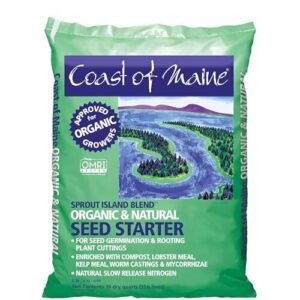
This premium organic mix delivers everything your seeds need from day one.
Premium organic nutrition meets seedling success from the very first day.
It combines mycorrhizae, worm castings, kelp, and fully cured compost in a ready-to-use blend that’s OMRI-listed for organic gardening.
The fine, friable texture prevents compaction while maintaining balanced moisture retention and drainage.
You’ll get consistently stronger seedlings with higher germination rates compared to standard household mixes.
At 16 quarts, it’s pricier than basic options but outperformed nine other organic brands in comparative trials, making it worth every penny for serious gardeners.
Best For: Serious gardeners or anyone starting seeds who wants reliable, high germination rates and organic-certified ingredients.
- Higher price point than standard seed starter mixes.
- Some users noted the presence of twigs or bark requiring sifting.
- May need extra hydration before use if mix is dry.
- Fine texture and balanced moisture support strong, healthy seedlings with minimal risk of compaction.
- Outperformed multiple organic brands for seedling growth and success.
- Contains high-quality organic components like mycorrhizae, worm castings, and kelp.
2. Happy Frog Potting Soil Mix
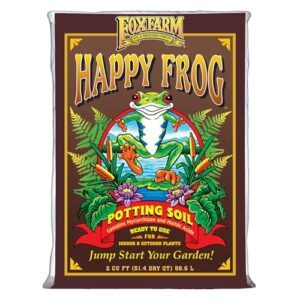
Creating seeds of success starts with Happy Frog Potting Soil Mix’s nutrient-rich foundation.
You’ll get aged forest products, earthworm castings, and mycorrhizal fungi working together to boost root development and nutrient uptake.
The pH-adjusted blend contains beneficial soil microbes that suppress harmful pathogens while promoting vigorous seedling growth.
At 45 pounds per 2-cubic foot bag, it’s pricier than alternatives but delivers consistent results.
You won’t find cheap fillers or construction waste here—just quality ingredients that help your seedlings flourish from day one.
Best For: Gardeners seeking a high-quality, organic potting mix for vigorous container and seed-starting success, indoors or out.
- Heavier and pricier than many alternatives, especially after shipping costs.
- Can float when watering and may require careful handling in containers.
- Some users may need to supplement calcium or adjust pH for sensitive crops.
- Boosts root growth and nutrient uptake with premium organic ingredients like mycorrhizal fungi and earthworm castings.
- Ready-to-use, pH-adjusted, and consistently reviewed for strong seedling and plant performance.
- No fillers or sludge; maintains soil health and disease resistance with beneficial microbes.
3. Organic Kelp Meal Fertilizer Blend
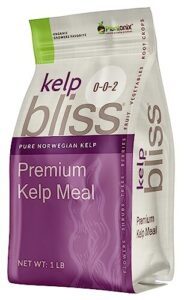
Beyond traditional potting mixes, you’ll find kelp meal offers exceptional nutritional density for your seedlings.
This ocean-harvested fertilizer delivers over 60 trace minerals, 12 vitamins, and 21 amino acids that synthetic alternatives can’t match.
Mix 1-2 tablespoons per gallon of potting soil for ideal results.
The naturally balanced NPK ratio of 1.3-0.1-1.7 promotes robust root development without burning tender seedlings.
Research shows 95% germination rates with kelp extract applications.
It’s sustainable, OMRI-certified, and enhances beneficial soil microbes that support long-term plant health.
Best For: Gardeners seeking an all-natural, sustainable fertilizer to boost seedling vigor and overall plant health in organic gardens.
- Delivers over 60 trace minerals and numerous vitamins for improved nutrient uptake and plant growth.
- OMRI-certified organic and sustainably harvested from renewable sea kelp sources.
- Enhances soil health by improving moisture retention and supporting beneficial microbes.
- Distinct ocean aroma may be off-putting to some users.
- Over-application can encourage unwanted mushroom growth.
- Lower NPK values mean less immediate impact compared to synthetic fertilizers.
4. Professional Medium Vermiculite Soil Conditioner

Vermiculite transforms your seed-starting game by acting like a microscopic sponge network. This sterile mineral absorbs up to four times its weight in water, creating perfect moisture conditions for germination.
You’ll love how it prevents damping-off disease while maintaining ideal air pockets around delicate roots.
Mix 25-50% vermiculite into your starting medium for superior water retention and drainage. Its lightweight nature makes handling effortless, and since it’s permanently sterile, you’re getting clean growing conditions every time.
Best For: Seed starters, home gardeners, and plant enthusiasts who want a low-maintenance, disease-resistant, and moisture-retentive growing medium.
- Excellent water retention and aeration for healthy seedling roots.
- Prevents damping-off and root diseases thanks to its sterile, non-toxic properties.
- Lightweight, easy to handle, and can be mixed with other growing media.
- Offers only moderate aeration compared to perlite.
- Finer texture may be less ideal for those wanting chunkier or more decorative soil amendments.
- Does not provide nutrients on its own, so requires supplementation with fertilizer or compost.
5. Organic Seed Starter Potting Soil
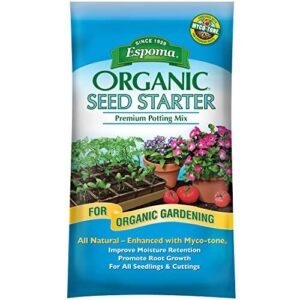
When you’re ready to step up your seedling game, Espoma’s Organic Seed Starter Potting Soil delivers professional results without breaking the bank.
This OMRI-certified blend combines sphagnum peat moss with perlite for ideal moisture balance, while its MYCO-TONE formula includes beneficial mycorrhizae that’ll boost root development from day one.
The fine texture guarantees excellent seed-to-soil contact, and the pH-balanced formula eliminates guesswork.
You’ll appreciate the clean, sterile composition that prevents damping off while supporting healthy germination across vegetables, herbs, and flowers.
Best For: Organic gardeners and home growers who want quick, healthy seed germination with minimal fuss and no synthetic additives.
- Fine, clean texture prevents disease and supports strong root growth.
- Contains mycorrhizae for improved nutrient uptake and plant resilience.
- OMRI-certified organic and free from synthetic chemicals.
- Dries out quickly and requires careful watering.
- Inconsistent results reported with old or poorly stored seeds.
- Not suitable for growers who prefer peat-free, coconut coir-based mixes.
6. black gold seed starting mix
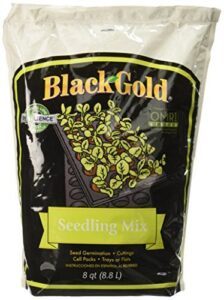
Black Gold’s seed starting mix delivers professional-grade performance with its OMRI-certified organic formula.
You’ll get Canadian sphagnum peat moss, perlite, and organic wetting agents that absorb water in minutes rather than hours.
The double-screened texture eliminates debris while supporting strong root development.
Though pricier than alternatives, users report faster germination rates and healthier seedlings.
Add extra perlite if you’re growing moisture-sensitive plants like peppers.
This mix works straight from the bag without amendments, providing a convenient solution for gardeners.
Best For: Gardeners starting seeds who want an organic, debris-free mix that delivers fast, reliable germination.
- OMRI-certified organic and free from synthetic chemicals
- Fine, double-screened texture supports strong, even root growth and quick water absorption
- Consistent results out of the bag with minimal pests and debris
- Pricier than some alternative seed starting mixes
- Can retain excess moisture if not managed, risking mold or seed loss
- Not suitable as a regular potting mix for older or larger plants
Key Benefits of Organic Seed Starter Mixes
Organic seed starting mixes provide your seedlings with essential nutrients while avoiding harmful chemicals that can stress young plants.
These specialized blends create ideal growing conditions through balanced moisture retention, proper drainage, and beneficial soil microorganisms that support healthy root development, and provide your seedlings with a good start by creating a balanced environment with essential nutrients.
Impact On Daily Life
Using organic seed starting mixes transforms your home gardening experience by giving you complete control over what feeds your family.
You’ll boost food security while creating meaningful family involvement opportunities that teach children valuable life skills.
- Health benefits: You eliminate synthetic chemicals from your food chain
- Cost savings: Growing your own produce reduces grocery bills substantially
- Organic gardening: Quality organic plant food guarantees the best seedling development naturally
Future Technological Integration
Smart sensors will revolutionize organic seed starting mixes by enabling automated fertilization systems that monitor soil moisture and nutrient levels.
AI diagnostics can detect early seedling stress before you notice symptoms.
Robotic transplanting reduces handling damage while maintaining beneficial soil microorganisms.
These technologies enhance traditional organic gardening practices, ensuring ideal nutrients reach developing seedlings through precise drone application and sensor monitoring systems.
Ethical Considerations
Choosing organic seed starting mixes reflects values beyond gardening success.
You’re supporting fair labor practices and ethical ingredient sourcing while reducing environmental impact.
Many organic products avoid GMO concerns and embrace biodynamic practices that work with natural systems.
Environmental sustainability drives these choices, prioritizing renewable resources over synthetic alternatives.
Organic certification guarantees adherence to strict organic standards, creating positive environmental impact throughout the supply chain, and ensuring renewable resources are used.
Choosing The Right Fertilizer for Seedlings
When you’re selecting fertilizer for your seedlings, you’ll need to examine three main factors: matching nutrient content to your specific plant types, ensuring proper water management through balanced retention and drainage, and choosing particle sizes that work with your seed dimensions.
Getting these elements right from the start prevents common problems like nutrient burn, poor germination rates, and seedling stress that can set back your entire growing season, ultimately affecting your ability to maintain proper water management.
Match Nutrient Needs and Seed Type
Different plants have unique nutrient requirements during the seedling stage, making seed-specific NPK ratios critical for success.
You’ll need organic fertilizer formulated to each plant type:
- Vegetables need balanced nutrition – Higher nitrogen for leafy growth
- Herbs require gentle feeding – Lower concentrations prevent overwhelming delicate seedlings
- Flowers demand phosphorus-rich blends – Supporting early root development and future blooms
Match your seedling fertilizer to specific nutrient requirements rather than using one-size-fits-all approaches for ideal seed starting results.
You can find various options for NPK seedling fertilizer online.
Balance Moisture Retention and Drainage
Proper water management keeps your seedlings healthy without drowning them.
Look for organic seed starting mixes with ingredients like perlite for drainage and vermiculite for moisture retention.
Mix Composition affects Watering Frequency—well-draining mixes need more frequent watering but prevent root rot.
Container Choice matters too; drainage holes are non-negotiable.
During the Seedling Stage, Root Health depends on balanced conditions that support steady seedling development.
Seedlings benefit from sphagnum peat moss for moisture retention, which is crucial for healthy seedlings and proper water management to prevent root rot.
Texture and Particle Size Considerations
Fine texture in seed starting mix creates better seedling contact with seeds, allowing proper root penetration and water movement.
Your seed starter mix should match seed size – tiny seeds need lightweight texture for germination, while larger seeds handle coarser particles.
Good texture promotes airflow and nutrient uptake, making your seed starting mix more effective overall.
Sterility and Disease Prevention in Seed Mixes
You can’t afford to take chances with seedling diseases that can wipe out your entire crop before it even gets started.
Clean, sterile seed starting mixes act as your first line of defense against damping off and other fungal problems that love to attack vulnerable young plants, providing a crucial barrier against diseases that can be devastating to your crop, and fungal problems are a significant threat to seedlings.
Reducing Risk of Damping Off
You’ll protect your seedlings from damping off disease by choosing sterile mixes that eliminate harmful pathogens.
Proper seed spacing and air circulation prevent moisture buildup that encourages fungal growth.
Smart watering practices—like bottom watering—keep soil moist without creating soggy conditions.
Quality seed starting mixes reduce disease risk substantially compared to garden soil.
Utilizing effective damping off prevention methods can further safeguard your seedlings with proper seed spacing and smart watering.
Importance of Heat-Treated and Sterile Mixes
Heat-treated organic seed starting mixes eliminate harmful pathogens while preserving beneficial microbes that support seedling health.
Sterilization methods create a safer growing environment that reduces damping off disease without compromising the soil microorganisms your plants need.
Three key advantages of sterile seed starter mix:
- Pathogen Reduction – Heat treatment destroys disease-causing fungi and bacteria that cause seedling mortality
- Disease Control – Sterile mixes prevent damping off and other common seedling infections from taking hold
- Beneficial Microbes – Quality sterilization preserves helpful organisms while eliminating harmful ones
Sustainability Considerations for Seed Starting
When choosing seed starting materials, you’re making decisions that impact both your garden and the environment.
Consider coconut coir over peat moss as a sustainable alternative that provides excellent water retention without depleting vulnerable peat bogs.
Organic Coconut Coir Vs. Peat Moss
When choosing between coconut coir and peat moss for your organic seed starter mix, you’ll find significant differences in sustainability and performance.
Coconut coir offers superior water retention while maintaining a neutral pH, unlike peat moss’s acidic nature requiring lime additions.
| Factor | Coconut Coir | Peat Moss |
|---|---|---|
| Sustainability | Renewable byproduct | Non-renewable, slow formation |
| Water Retention | 73-80% capacity | 60-68% capacity |
| pH Level | Near-neutral (5.7-6.8) | Acidic (3.0-4.5) |
| Environmental Impact | Minimal habitat disruption | Bog destruction, CO2 release |
| Cost | Generally lower | Higher due to extraction |
Coir’s sustainability advantage stems from utilizing coconut waste that would otherwise be discarded, while peat extraction destroys ancient bog ecosystems.
For seed starting applications, coir’s consistent moisture distribution and resistance to compaction create ideal germination conditions without the hydrophobic issues that plague dried peat moss.
Peat moss, however, effectively absorbs nutrients, potentially leading to healthier plant development.
Environmentally Friendly Ingredients
Beyond choosing sustainable sourcing for your organic ingredients, you’ll want renewable inputs that minimize environmental impact.
Natural fertilizers from renewable resources support both plant health and planetary wellness through thoughtful ingredient selection.
- Biodegradable Packaging: Choose brands using compostable bags instead of plastic containers
- Reduced Carbon: Select locally-sourced organic seed starting mixes to cut transportation emissions
- Waste Reduction: Pick sustainable ingredients like coconut coir that repurpose agricultural byproducts
Organic Nutrients and N-P-K Explained
Understanding N-P-K ratios helps you choose the right organic fertilizer for healthy seedling development.
These three numbers tell you exactly what nutrients you’re feeding your young plants and how they’ll respond to different formulations, which is crucial for healthy seedling development.
What Each N-P-K Number Means
Understanding fertilizer labels can feel like cracking a secret code, but it’s simpler than you think.
Those three numbers on every seed starting fertilizer package represent nitrogen (N), phosphorus (P), and potassium (K) percentages by weight.
Each nutrient plays a specific role in your seedlings’ development. NPK balance determines how well your plants grow, while deficiency symptoms appear when ratios are off in seedling fertilizers.
These nutrients, often called NPK in fertilizers, are the foundation of plant health.
How Nutrients Affect Seedling Growth
Nitrogen fuels chlorophyll production and vigorous leaf growth, while phosphorus drives robust root development in your seedlings.
Potassium strengthens stem structure and boosts disease resistance.
When organic nutrients work together, they prevent nutrient deficiency and support balanced seedling growth.
Proper nutrient absorption guarantees essential nutrients reach developing tissues, creating healthier transplants for your garden.
When and How to Fertilize Seedlings
Timing your seedling fertilization correctly makes the difference between thriving plants and stressed seedlings that struggle to grow.
You’ll want to wait until those first true leaves appear before adding any nutrients, then use gentle application methods to avoid burning those tender roots.
Fertilize After True Leaves Appear
Your seedlings don’t need fertilizer until they develop their first true leaves. The cotyledon nutrient store provides everything they need initially. True leaves matter because they signal the plant’s ready for additional seedling nutrients.
Here’s when to start feeding:
- Wait for two sets of true leaves – typically 2-4 weeks after germination
- Check seedling height – plants should reach 2-3 inches tall
- Watch for yellowing cotyledons – they’ll drop off naturally
Starting seedling fertilizer too early causes seedling burn and stress. NPK balance becomes important only after true leaves appear, making dilution importance vital for healthy seedling feeding.
Dilution and Application Methods
You should dilute organic fertilizers to quarter or half strength when feeding seedlings.
Start with liquid fertilizer at 1:4 ratio (one part fertilizer to four parts water) for gentle feeding. Bottom watering prevents fertilizer burn on delicate leaves while ensuring proper root absorption.
Understanding the NPK ratio importance can help tailor the fertilizer to the seedling’s needs.
Apply diluted solutions weekly, following fertilizer directions for proper fertilizer concentration and application frequency.
Avoiding Over-Fertilization
Over-fertilization creates more problems than solutions for your delicate seedlings. Even organic fertilizer can cause nutrient burn when applied too heavily or frequently. Start with quarter-strength dilutions and watch for warning signs.
- Seedling burn symptoms: Yellow leaves, brown crispy edges, stunted growth
- Dilution importance: Begin with ¼ strength, gradually increase as plants mature
- Monitoring growth: Check weekly for vigor, color changes, leaf development
- Application methods: Water soil first, then apply diluted fertilizer to prevent shock
- Recovery strategy: Flush with plain water immediately if burn symptoms appear
Common Mistakes to Avoid With Seedlings
Even experienced gardeners can sabotage their seedlings with well-meaning but misguided care. You’ll set yourself up for success by recognizing these common pitfalls before they damage your precious plants.
Overwatering and Fertilizer Burn
Two major threats can destroy your seedlings before they reach maturity. Overwatering creates waterlogged conditions that suffocate roots and promote fungal diseases. Fertilizer burn occurs when you apply seedling fertilizer at full strength, causing salt buildup that damages delicate root systems.
| Problem | Identifying Symptoms | Prevention Tips |
|---|---|---|
| Overwatering | Yellowing leaves, musty smell, wilted appearance despite wet soil | Water only when top inch feels dry, guarantee proper drainage |
| Fertilizer Burn | Brown leaf edges, stunted growth, white salt deposits on soil | Dilute organic fertilizer to half strength, apply sparingly |
| Root Health Issues | Black or mushy roots, poor growth despite care | Use sterile potting mix, avoid disturbing roots unnecessarily |
| Salt Buildup | White crusty residue on containers, leaves curling downward | Flush soil monthly with plain water, reduce fertilizer frequency |
| Recovery Methods | Immediate action needed to save affected plants | Stop fertilizing, improve drainage, remove damaged tissue carefully |
Monitor your seedlings daily for these warning signs. Remember that seedling care tips emphasize "less is more" – young plants need gentle treatment to develop strong root health and avoid these common pitfalls.
Choosing The Wrong Mix or Fertilizer
Three costly mistakes can derail your seedling success before they even start growing.
Choosing inappropriate seed starter mix or fertilizer for seeds creates multiple problems:
- Dense mixes cause stunted growth – Heavy soils restrict oxygen flow and prevent proper root development
- Wrong nutrient timing triggers root damage – Adding fertilizer too early promotes disease susceptibility and nutrient burn
- Poor drainage leads to seedling death – Waterlogged conditions encourage damping off and nutrient imbalance
These mistakes can be critical, and understanding their impact is essential for successful seedling growth.
Tips for Maximizing Organic Germination Success
Perfect timing beats perfect soil. You’ll get stronger germination when you slightly moisten your seed starting mix before sowing, which prevents seeds from floating or shifting during watering.
Moistening Mix Before Sowing
Proper hydration transforms dry organic seed starting mixes into the perfect growing environment.
You’ll want to achieve even moisture throughout without creating waterlogged conditions that harm seedling development.
| Hydration Method | Water Type | Mixing Technique |
|---|---|---|
| Pre-Sowing Hydration | Sterile Water | Gradual spraying while stirring |
| Gradual Absorption | Room temperature water | Mix small amounts, wait 5 minutes |
| Even Moisture Check | Distilled or filtered | Squeeze test – no dripping |
| Avoiding Clumps | Lukewarm water | Break apart dense spots |
Start by adding water slowly to your seed starter mix while stirring continuously.
This prevents clumps and helps moisture retention reach every particle.
The mix should feel like a wrung-out sponge when properly hydrated.
Organic seed starting mixes need time to absorb water evenly, so patience pays off here.
Well-moistened seed starting mixes create ideal conditions for germination success.
Monitoring Seedling Health
Watch your seedlings like a hawk during their first few weeks. Check leaf color daily for yellowing or browning that signals nutrient burn or disease.
Inspect growth rate – healthy seedlings should show steady development. Look for wilting, stunted growth, or pest identification signs.
Well-draining soil is essential for preventing root rot.
Root inspection reveals white, firm roots indicating good seedling health and vigor.
Adapting Fertilizer to Plant Needs
Different plants require specific nutrient timing and balanced fertilizer ratios throughout their seedling growth stages.
You’ll need to match your organic fertilizer to each plant’s unique seedling nutrient needs and watch for deficiency signs:
- Heavy feeders (tomatoes, peppers) need higher nitrogen ratios like 5-2-3
- Light feeders (herbs, lettuce) prefer balanced 4-4-4 formulations
- Root crops benefit from phosphorus-rich mixes during early development
- Soil testing helps determine specific NPK requirements before application
The provided list outlines the specific needs of different plant types, emphasizing the importance of tailored fertilizer application for optimal growth.
Frequently Asked Questions (FAQs)
What is a good organic fertilizer for seedlings?
Ironically, your delicate seedlings need gentle feeding to avoid burning their tender roots.
Fish emulsion fertilizer works perfectly – it’s mild, organic, and provides balanced nutrients when those first true leaves appear.
How to make homemade seedling fertilizer?
You can create homemade seedling fertilizer by mixing compost tea, diluted fish emulsion, or blending kitchen scraps like banana peels and eggshells for nutrient-rich, cost-effective plant food.
What fertilizer to use when seeding?
You don’t need fertilizer when first seeding – seeds contain enough nutrients for initial germination.
Wait until true leaves appear, then start with diluted, balanced fertilizer like 4-4-4 at half strength.
Should you fertilize newly planted seeds?
Like dormant potential waiting beneath soil, seeds contain everything they need to sprout.
You shouldn’t fertilize newly planted seeds—they carry their own nutrients. Wait until true leaves appear before feeding.
Can organic fertilizers burn or damage young seedlings?
Yes, organic fertilizers can burn seedlings if you apply them too heavily or too early.
You’ll avoid damage by using half-strength dilutions and waiting until true leaves appear before fertilizing your young plants.
Whats the shelf life of liquid organic fertilizers?
Time’s ticking on your liquid fertilizer investment.
Most liquid organic fertilizers maintain potency for 2-3 years when stored properly in cool, dark places.
You’ll know they’ve expired when sediment separates or foul odors develop.
Can you make homemade organic seed starting mix?
You’ll create excellent homemade seed starting mix by combining equal parts peat moss or coco coir, vermiculite, and perlite with compost for nutrients.
Do organic fertilizers attract pests or insects indoors?
While aromatic fish emulsion and kelp-based fertilizers smell enticing to you, they’ll also attract curious pets and unwelcome insects indoors.
You’re better off applying these smelly organic options outdoors to avoid turning your home into a pest magnet.
Conclusion
Like a compass guiding your gardening journey, choosing the right organic seed starting fertilizer options sets the foundation for thriving seedlings.
You’ll achieve ideal germination rates by selecting balanced N-P-K formulations, maintaining proper moisture levels, and timing fertilizer applications correctly.
Remember to wait for true leaves before feeding, dilute concentrations appropriately, and prioritize sterile mixes to prevent damping-off.
These organic approaches build healthier soil biology while supporting robust root development for successful transplanting.
- https://naturesseed.com/planting-aids/organic-seed-starter-fertilizer-4-6-4/
- https://pmc.ncbi.nlm.nih.gov/articles/PMC10893865/
- https://sustainableholly.com/15-easy-organic-fertilizers-to-make-at-home/
- https://shiftingroots.com/how-to-fertilize-your-seedlings/
- http://www.subplantsci.org/wp-content/uploads/2016/02/SPS6208_MATOCHA_GALLEY-FINAL_PDF.pdf

